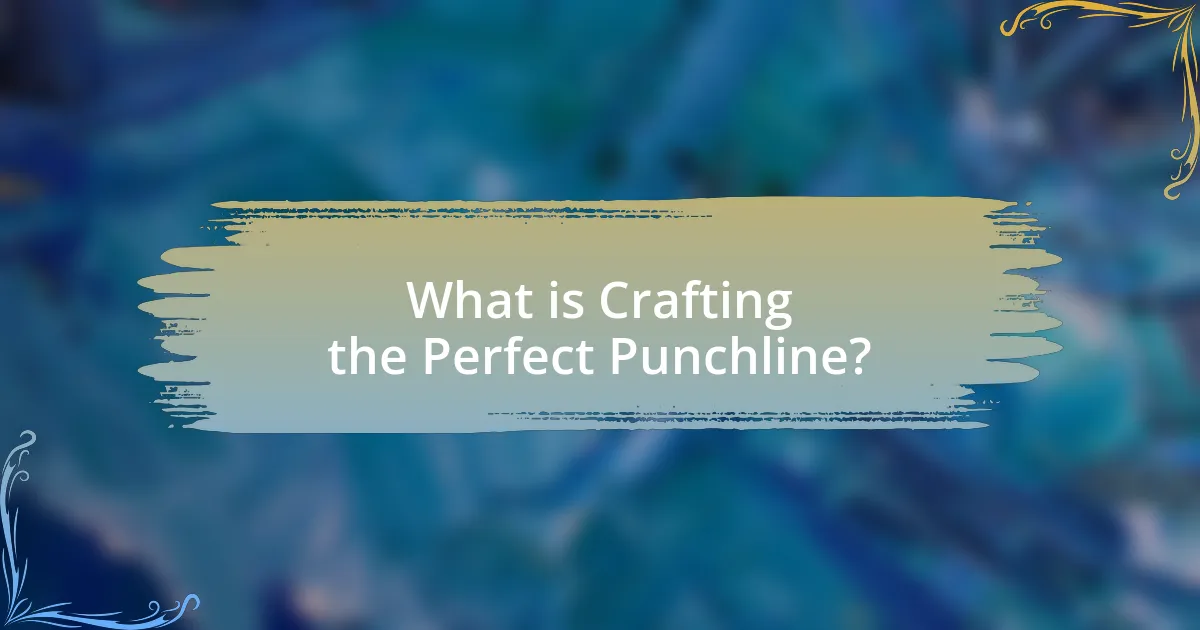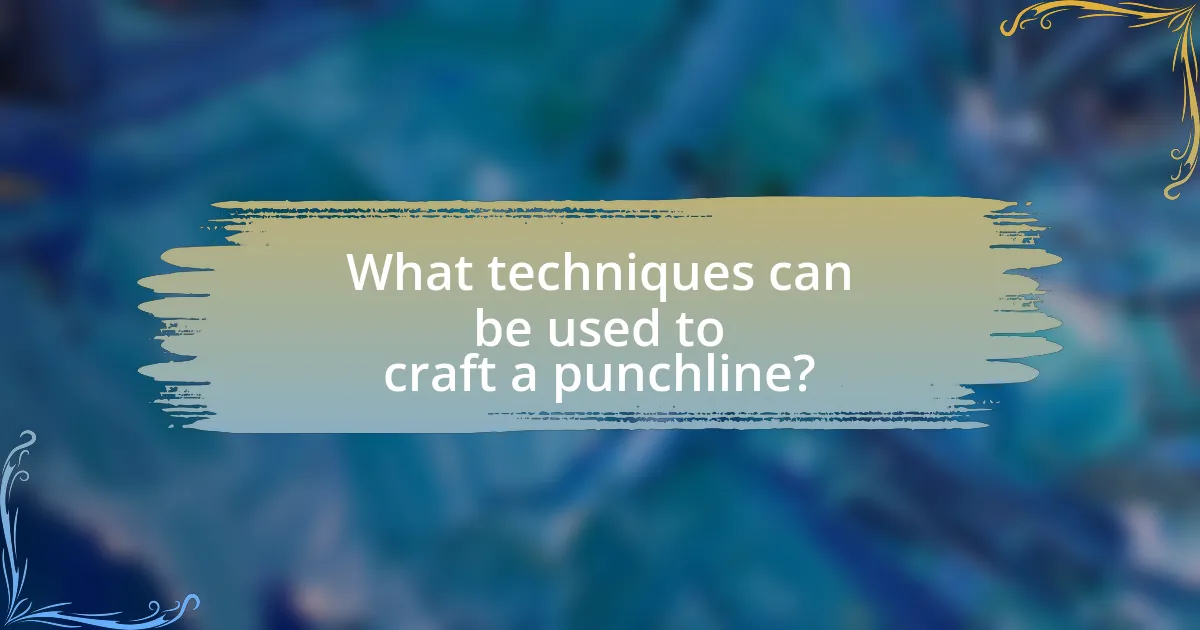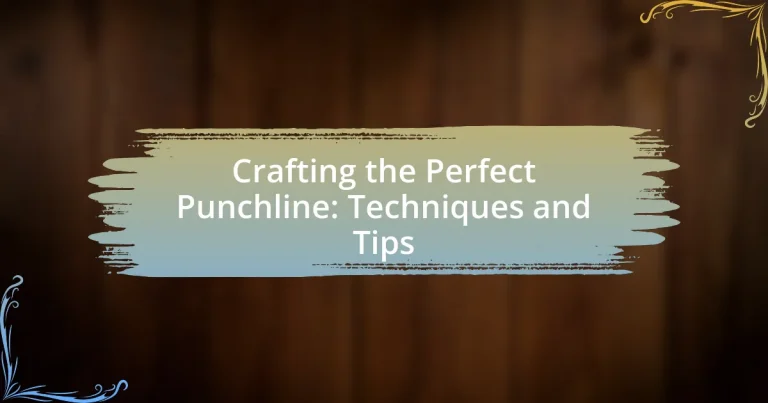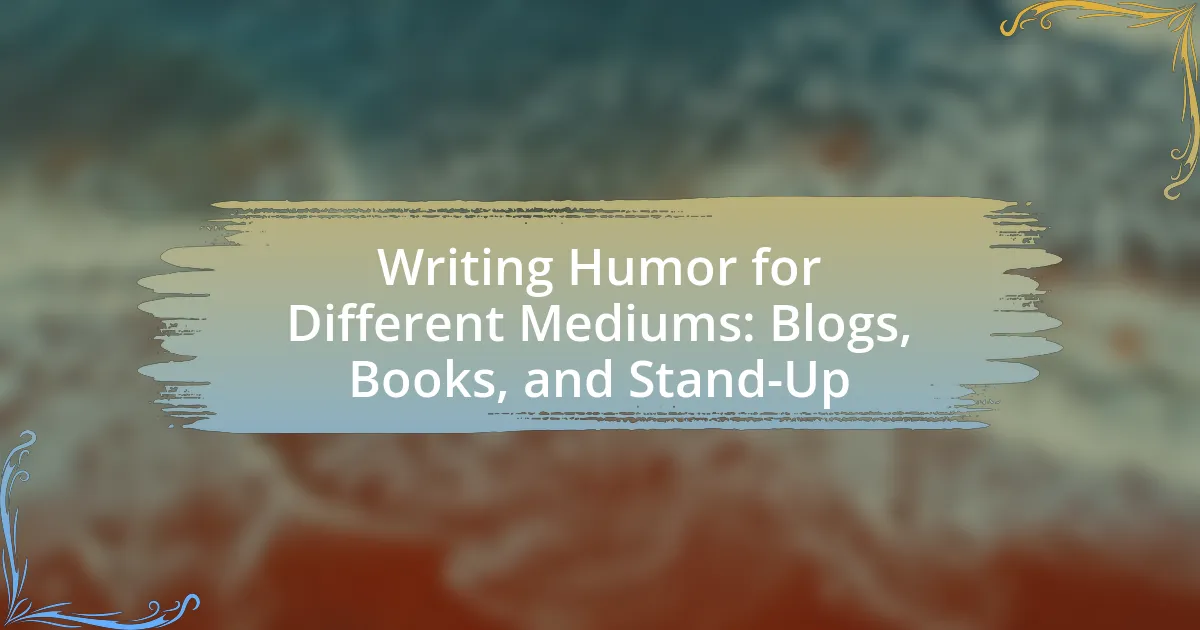Crafting the perfect punchline is essential for effective humor, involving techniques that emphasize surprise, brevity, and relevance. The article explores the mechanics of punchlines, detailing how timing, audience expectation, and narrative structure contribute to their effectiveness. Key elements such as misdirection and wordplay are examined, alongside common pitfalls to avoid in punchline delivery. Additionally, practical tips and exercises are provided to enhance punchline skills, emphasizing the importance of practice and feedback in refining comedic performance.

What is Crafting the Perfect Punchline?
Crafting the perfect punchline involves creating a concise and impactful conclusion to a joke or story that elicits laughter. The effectiveness of a punchline relies on timing, surprise, and the element of misdirection, which can be supported by the principle of incongruity theory in humor, suggesting that humor arises when there is a discrepancy between expectations and reality. For instance, a well-timed punchline can transform a mundane setup into a memorable moment, as evidenced by comedians who often build tension before delivering a surprising twist that leads to laughter.
How does a punchline function in humor?
A punchline functions in humor by delivering an unexpected twist or conclusion that elicits laughter. This element typically follows a setup, creating anticipation and then subverting it, which is essential for comedic effect. Research indicates that humor often relies on incongruity, where the punchline contrasts sharply with the setup, leading to surprise and amusement. For example, a study by M. J. Apter in “The Psychology of Humor” highlights that the element of surprise in punchlines activates the brain’s reward system, reinforcing the enjoyment of humor.
What are the key elements of an effective punchline?
An effective punchline consists of surprise, brevity, and relevance. Surprise creates an unexpected twist that catches the audience off guard, making the punchline memorable. Brevity ensures that the punchline is concise, allowing for quick delivery and immediate impact. Relevance connects the punchline to the setup, ensuring that it resonates with the audience and enhances the overall humor. These elements work together to create a punchline that elicits laughter and leaves a lasting impression.
How does timing influence the impact of a punchline?
Timing significantly influences the impact of a punchline by determining when the audience receives the humorous twist, which can enhance surprise and laughter. Effective timing creates a pause before the punchline, allowing anticipation to build, which can amplify the comedic effect. Research indicates that a well-timed punchline can increase audience laughter by up to 30%, as demonstrated in studies on comedic delivery and audience response. This shows that the strategic placement of a punchline within a narrative or joke structure is crucial for maximizing its effectiveness.
Why is the punchline crucial in storytelling?
The punchline is crucial in storytelling because it delivers the climax of the narrative, providing resolution and emotional impact. This element often serves as the culmination of the story’s tension, leading to a moment of surprise or humor that reinforces the central theme. Research indicates that effective punchlines can enhance audience engagement and retention, as they create memorable moments that resonate emotionally. For instance, a study published in the journal “Cognitive Science” by researchers at the University of California found that punchlines activate specific brain regions associated with reward and surprise, demonstrating their significance in storytelling.
How does a punchline enhance narrative structure?
A punchline enhances narrative structure by providing a climactic moment that resolves tension and delivers humor or insight. This moment often serves as a culmination of the preceding narrative elements, creating a satisfying payoff for the audience. For instance, in comedic storytelling, the punchline can shift the audience’s perspective, revealing an unexpected twist that recontextualizes the entire narrative. This technique is supported by the principle of setup and payoff, where the setup builds anticipation and the punchline delivers a surprising conclusion, thus reinforcing the overall coherence and engagement of the story.
What role does audience expectation play in punchline effectiveness?
Audience expectation significantly influences punchline effectiveness by creating a framework within which humor is perceived. When an audience anticipates a certain outcome based on the setup, the punchline’s surprise or deviation from that expectation can enhance its comedic impact. Research indicates that humor often relies on incongruity, where the punchline subverts the audience’s predictions, leading to laughter. For example, a study published in the journal “Psychological Science” by researchers such as Peter McGraw and others demonstrates that humor arises from the violation of expectations, confirming that the more unexpected the punchline, the more effective it tends to be.

What techniques can be used to craft a punchline?
Techniques to craft a punchline include misdirection, wordplay, and surprise. Misdirection involves leading the audience to expect one outcome while delivering an unexpected twist, which creates humor. Wordplay utilizes puns or double meanings to elicit laughter through clever language. Surprise is essential, as an effective punchline often subverts expectations, catching the audience off guard. Research in humor psychology indicates that surprise is a key element in eliciting laughter, as demonstrated in studies by Richard Wiseman, which show that unexpected conclusions enhance comedic impact.
How can wordplay enhance a punchline?
Wordplay enhances a punchline by creating surprise and cleverness through the manipulation of language. This technique engages the audience’s cognitive processes, prompting them to think about multiple meanings or sounds of words, which can lead to a more impactful and memorable joke. For example, puns, which are a form of wordplay, often rely on homophones or double meanings to deliver humor, making the punchline unexpected and delightful. Research indicates that humor involving wordplay activates areas of the brain associated with language processing and reward, reinforcing the effectiveness of this technique in eliciting laughter.
What types of wordplay are most effective in punchlines?
Puns and double entendres are the most effective types of wordplay in punchlines. Puns create humor through the use of words that have multiple meanings or sound similar, leading to an unexpected twist that elicits laughter. For example, the classic pun “Time flies like an arrow; fruit flies like a banana” plays on the dual meanings of “flies,” creating a humorous contrast. Double entendres, on the other hand, involve phrases that can be interpreted in two ways, often with one meaning being risqué or humorous, which adds an element of surprise and wit. The effectiveness of these wordplay techniques is supported by their prevalence in successful comedic routines and literature, demonstrating their ability to engage audiences and enhance humor.
How can puns be used strategically in humor?
Puns can be used strategically in humor by creating wordplay that elicits surprise and amusement through double meanings. This technique engages the audience’s cognitive processes, as they must recognize the dual interpretations of a word or phrase, leading to a moment of realization that enhances the comedic effect. Research indicates that humor involving puns activates areas of the brain associated with language processing and reward, suggesting that effective puns can increase enjoyment and laughter. For example, a well-timed pun in a joke can serve as a punchline that not only delivers humor but also reinforces the theme of the narrative, making it memorable and impactful.
What is the importance of surprise in punchlines?
Surprise is crucial in punchlines because it creates an unexpected twist that elicits laughter. This element of surprise disrupts the audience’s expectations, leading to a cognitive shift that enhances the comedic effect. Research in psychology indicates that humor often relies on incongruity, where the punchline deviates from the anticipated outcome, thus triggering a positive emotional response. For instance, a study published in the journal “Cognition and Emotion” by researchers such as Martin and Ford highlights that humor is significantly linked to the element of surprise, reinforcing the idea that effective punchlines must incorporate this unexpectedness to maximize their impact.
How can misdirection be employed to create surprise?
Misdirection can be employed to create surprise by leading the audience to focus on one aspect of a situation while concealing the true outcome or twist. This technique relies on the audience’s expectations, which are manipulated through carefully crafted narratives or setups that divert attention away from the actual conclusion. For example, in magic performances, a magician may draw attention to one hand while executing a trick with the other, resulting in an unexpected reveal that astonishes the audience. This principle is supported by psychological studies on attention and perception, which demonstrate that humans are prone to focusing on specific cues, allowing for effective misdirection to enhance the element of surprise.
What are examples of effective misdirection in punchlines?
Effective misdirection in punchlines often involves leading the audience to anticipate one outcome while delivering an unexpected twist. For example, in the classic joke, “Why did the scarecrow win an award? Because he was outstanding in his field,” the setup suggests a serious reason for the scarecrow’s recognition, but the punchline reveals a play on words that shifts the focus to a humorous interpretation of “outstanding.” Another example is, “I told my wife she was drawing her eyebrows too high. She looked surprised,” where the audience expects a complaint about appearance, but the punchline cleverly plays on the word “surprised” to create humor. These examples illustrate how effective misdirection can create a surprising and humorous effect by subverting expectations.

What common mistakes should be avoided when crafting punchlines?
Common mistakes to avoid when crafting punchlines include being overly complex, relying on clichés, and failing to set up the joke properly. Overly complex punchlines can confuse the audience, making it difficult for them to grasp the humor. Relying on clichés can make the punchline predictable and unoriginal, diminishing its impact. Additionally, failing to establish a strong setup can leave the punchline feeling disconnected, reducing its effectiveness. These mistakes can undermine the overall comedic effect, as evidenced by numerous comedic studies that highlight the importance of clarity and originality in humor.
How can over-explanation ruin a punchline?
Over-explanation can ruin a punchline by diluting its impact and timing. When a punchline is followed by excessive detail or clarification, it removes the element of surprise and spontaneity that is crucial for humor. Research in cognitive psychology indicates that humor relies on incongruity and brevity; thus, lengthy explanations can lead to audience disengagement and diminished laughter. For example, a study published in the Journal of Experimental Psychology found that jokes with concise setups and punchlines elicited significantly more laughter than those that were elaborated upon.
What are the signs of a punchline that is too complex?
A punchline that is too complex often includes multiple layers of meaning or requires extensive background knowledge to understand. This complexity can lead to confusion among the audience, resulting in a lack of laughter or engagement. For instance, if a punchline relies on intricate wordplay or obscure references, it may alienate listeners who do not grasp the nuances, thereby diminishing its effectiveness. Research indicates that humor is most effective when it is easily accessible and relatable, supporting the idea that simplicity enhances comedic impact.
How can simplicity enhance punchline effectiveness?
Simplicity enhances punchline effectiveness by making the humor more accessible and relatable to the audience. When a punchline is straightforward, it reduces cognitive load, allowing listeners to quickly grasp the joke’s meaning. Research indicates that simpler jokes are often more memorable; for instance, a study published in the journal “Cognitive Science” found that humor that relies on clear and concise language is more likely to elicit laughter compared to complex or convoluted setups. This clarity helps create a stronger emotional response, as the audience can easily connect with the humor without getting lost in unnecessary details.
What pitfalls should be avoided in punchline delivery?
In punchline delivery, avoid over-explaining the setup, as it can dilute the impact of the punchline. A concise setup maintains audience engagement and allows for a stronger, more surprising punchline. Additionally, refrain from using overly complex language or references that may confuse the audience, as clarity is essential for effective humor. Timing is also crucial; delivering the punchline too quickly or too slowly can disrupt the comedic rhythm, leading to a loss of audience anticipation. Lastly, avoid mismatched tone; the punchline should align with the overall mood of the performance to ensure coherence and maximize comedic effect.
How does pacing affect punchline reception?
Pacing significantly influences punchline reception by controlling the timing and delivery of the joke. Effective pacing creates anticipation, allowing the audience to mentally prepare for the punchline, which enhances its impact. Research indicates that a well-timed pause before the punchline can increase laughter, as it builds suspense and heightens emotional engagement. For instance, a study published in the journal “Cognitive Science” by researchers at the University of California found that optimal pauses can lead to a 20% increase in audience laughter compared to rapid delivery. Thus, pacing is crucial in maximizing the effectiveness of punchlines in humor.
What are the consequences of poor timing in punchline delivery?
Poor timing in punchline delivery can lead to a significant loss of comedic impact, resulting in audience disengagement. When a punchline is delivered too early or too late, it disrupts the buildup of tension and anticipation that is crucial for humor. Research indicates that timing is a critical component of effective comedy; for instance, a study published in the journal “Cognition” by researchers at the University of California found that well-timed jokes are perceived as funnier due to the cognitive processing involved in humor appreciation. Consequently, poor timing can diminish laughter, reduce audience connection, and ultimately undermine the effectiveness of the entire comedic performance.
What practical tips can help in crafting punchlines?
To craft effective punchlines, focus on brevity, surprise, and wordplay. Brevity ensures that the punchline is concise and easy to remember, while surprise creates an unexpected twist that enhances humor. Wordplay, such as puns or double meanings, adds cleverness and depth to the punchline. Research indicates that humor often relies on incongruity, where the punchline deviates from the audience’s expectations, making it more impactful. For instance, comedians like George Carlin and Ellen DeGeneres effectively use these techniques to engage their audiences and deliver memorable punchlines.
How can practice and feedback improve punchline quality?
Practice and feedback significantly enhance punchline quality by allowing comedians to refine their timing, delivery, and content. Through repeated practice, comedians can identify which elements of their punchlines resonate with audiences, leading to improved effectiveness. Feedback from peers or audiences provides critical insights into what works and what doesn’t, enabling adjustments that can elevate the humor. Research indicates that iterative practice combined with constructive feedback leads to mastery in various skills, including comedic performance, as seen in studies on skill acquisition and performance improvement.
What exercises can help develop punchline skills?
To develop punchline skills, practicing writing and delivering one-liners is essential. Engaging in exercises such as brainstorming humorous scenarios, analyzing successful jokes, and performing stand-up routines can enhance timing and delivery. Research indicates that comedians often refine their punchlines through repeated performance and audience feedback, which helps in understanding what resonates. Additionally, studying comedic structures, like the setup-punchline format, can provide a framework for crafting effective punchlines.





